
Tricotyledon Echinocactus polycephalus seedling
As mentioned in the previous post I started a handful of Echinocactus polycephalus (SNL 91; Las Vegas, Nevada) from seed a few weeks ago. I didn't achieve impressive germination rates and many of the seedlings were killed off by mold while still enclosed in the humid atmosphere of the germination "tent" - and more have withered after I exposed the seedlings to the harsher environment outside of the plastic bag they germinated in. So for all practical purposes Echinocactus polycephalus (and E. horizonthalonius) live up to their reputation of being extremely difficult to grow from seed.

Echinocactus polycephalus seedling growing its first spines
That being said a few of the seedlings are doing great - exemplified by the Echinocactus polycephalus seedling pictured above, growing its first spines.

Tricotyledon Echinocactus polycephalus seedling - top view
Interestingly one of the Echinocactus polycephalus seedlings turned out to be a tricotyledon. Members of the Cactus family belong to the group of dicotyledons, i.e. their seedlings have two cotyledons or embryonic leaves. So evidently Echinocactus polycephalus is a dicot but for some reason this seedling decided to grow three seed leaves instead of the habitual two.
Polycotyledons could be considered freaks of nature or "mutant" plants but this seedling will probably grow up looking exactly like the other plants from the same batch. The last time I experienced a polycot seedling was some years ago when an Opuntia polyacantha var. hystricina seedling germinated with three seed leaves.

Tricotyledon Opuntia polyacantha var. hystricina seedling
Polycotyledon tomato, chile, aubergine, Cannabis, etc are regularly reported so this is by no means abnormal. It would be interesting to know though if this is affecting the plants in any way (as mentioned, the last time I experienced a tricot seedling the plant grew up to be indistinguishable from the "normal" plants). I'm also curious as to what is causing the extra seed leaves (the Opuntia seedling mentioned above was grown fresh from seed collected in the Grand Canyon; indicating to me that polycots are occurring naturally and are not (only) caused by "mutagens" in the environment).
Tuesday, July 23, 2013
Tricotyledon Echinocactus polycephalus seedling
Tuesday, June 25, 2013
Growing Echinocactus polycephalus and Echinocactus horizonthalonius from seed
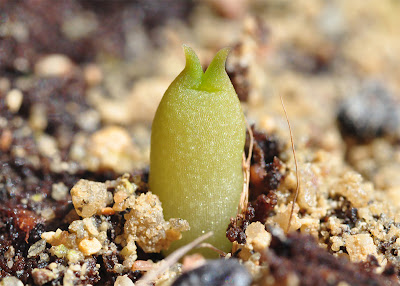
Immaculate Echinocactus polycephalus seedling
Back in 2009 I bought 100 seeds each of Echinocactus polycephalus (SNL 91; Las Vegas, Nevada) and Echinocactus horizonthalonius (SB 409; Shafter, Texas) from Mesa Garden. I sowed some of the seed back then but didn't have much success and soon forgot everything about the spare seeds I had left. That is until a few days ago :-)
As the seeds, in my (limited) experience, are extremely hard to germinate I decided to scarify them with a scalpel. You have to be very careful not to damage the embryo when making shallow cuts in the testa (seed coat) with a scalpel - and manually scarifying 80-some tiny seeds is an extreme test of your patience. After brutally cleaving several seed embryos I settled for chipping away at the protrusion of the hilum - this allowed me to break of small pieces of the testa without damaging the embryo within. The scarified seeds were left to soak in water for a few hours - I added the smallest tad of detergent to remove the water surface tension and allow for more efficient soaking of the seeds.
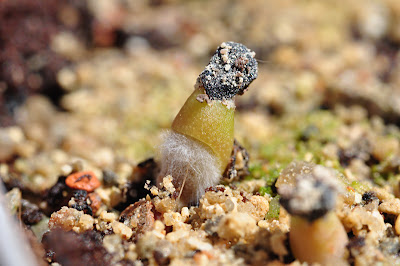
Echinocactus polycephalus seedling in the process of damping off - killed by mold
A few days after sowing the seeds several seedlings have surfaced. Unfortunately a few of them are already showing "rusty" spots and some has completely damped off, killed by mold. Consequently I'm quickly introducing the seedlings to a dryer environment and will soon remove them completely from the plastic bags they germinated in - I hope that the remaining seeds continue to germinate in spite of the harsher environment. Steve Brack's encouraging notes regarding this type of cacti reads: "rot easily, right after germination: not too wet, dry air and stronger light."

Etiolated Echinocactus polycephalus seedling, red from the sun
Some of the seedlings seem to have a hard time ridding themselves of the spent seed coat. They grow slightly etiolated and don't develop much chlorophyl in the deep shade of the testa - consequently they turn all red when exposed to the sunlight.

Echinocactus polycephalus seedling showing "rusty" spots
As usual I'm germinating my seeds in pots placed in clear plastic bags. As it's early summer I'm experimenting with germinating the seeds outdoors on the balcony - the daytime temperatures are around 20 C (68 F) with pleasantly cool nights. The temperature inside the bags off course grow hotter as they are exposed to sun during the day.

Bags containing Echinocactus, Ariocarpus, Aztekium, and peyote seedlings
With time I hope that my seedlings grow to look like this beautiful cluster of Echinocactus polycephalus (var. xeranthemoides) that overlooks the Tonto Platform in the Grand Canyon

Echinocactus polycephalus (var. xeranthemoides) overlooking the Tonto Platform
The Echinocactus horizonthalonius seedlings seem somewhat easier and more "well behaved". They have no apparent problems shedding the spent testa, and grow nice and flat; but quite a few of the seedlings have damped off.

Echinocactus horizonthalonius seedling

Echinocactus horizonthalonius seedling ridding itself of the spent seed coat
It's probably not going to be in my lifetime, but I hope my seedlings will grow to look like the fine specimen featured at the Chrudimský Kaktusář web site:

Flowering Echinocactus horizonthalonius
Tuesday, July 13, 2010
Echinocactus horizonthalonius seedling pictures
Late May I started 20 Echinocactus horizonthalonius seeds (SB 409; Shafter, Texas) and for several weeks nothing happened. But lately it has been extremely hot in Denmark and these weather conditions seem conducive to the germination of E. horizonthalonius.
Echinocactus horizonthalonius seedling, close-up
Two days ago 5 Echinocactus horizonthalonius seedlings had germinated – 25% is not an impressive germination rate, I know, but still I'm quite satisfied as these seeds seem notoriously difficult to germinate (in my meager experience with Echinocactus anyway ;-) 
Echinocactus horizonthalonius seedling
I look forward to growing these plants and hope they with time will grow to look like the beautiful Echinocactus horizonthalonius specimen pictured below ;-)
Echinocactus horizonthalonius, San Luis Potosí
The above habitat photo is by Kauderwelsch and is licensed under the “Creative Commons Attribution-Share Alike” license. The original picture can be found at the Wikimedia Commons.
Wednesday, October 14, 2009
A few Ariocarpus plants and a handful of Echinocactus seeds from Mesa Garden
I'm not a seasoned Ariocarpus grower but still in a slow but steady process of building a collection of these magnificent plants. I'm learning to handle the deep levels of patience required to grow Ariocarpus from seed, but sometimes I give in to my eagerness and have to buy a few plants ;-)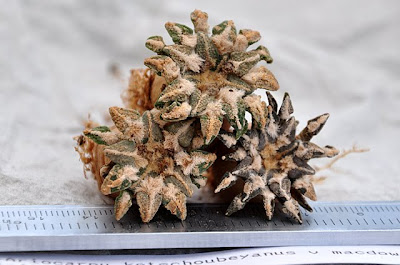
Ariocarpus kotschoubeyanus v. macdowellii
I like Mesa Garden's hard grown plants that almost invariably come with locality information. As I live in Denmark and Mesa Garden is located in New Mexico it is quite cumbersome and expensive to import plants (I once contacted the Danish plant directorate to get directions on importing cacti from countries outside of the European Union and was told it would involve import permits, CITES and phytosanitary documents plus an inspection of the plants upon arrival). To work around these obstacles I order plants whenever in the US and have them shipped to my hotel; from there they travel to Denmark packed in my suit case.
Ariocarpus kotschoubeyanus v. macdowellii, side view
I have only praise for the service offered by Mesa Garden, they are always responsive and extremely helpful in arranging timely deliveries - even within very short windows of time. Remember to specify substitutes, though. 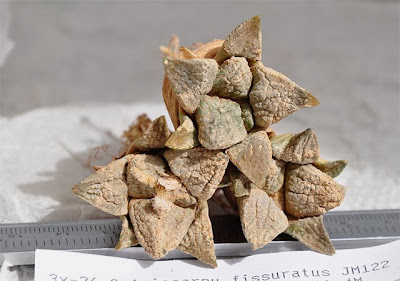
Ariocarpus fissuratus
I spent part of my summer vacation in New York City and again took the opportunity to order plants and seeds from Mesa Garden. Apart from the Ariocarpus kotschoubeyanus var. macdowellii (SB 100; El Pilar, Coahuila) and A. fissuratus (JM 122; Fort Stockton, Texas) featured in this post, I also ordered some Ariocarpus intermedius and A. retusus. Unfortunately Steven was out of the varieties I ordered of the latter two species, and I forgot to specify substitutes and consequently received only half of the plants that I ordered. Disappointing as it may be not to receive all the plants you are eagerly expecting, this is the only approach that makes sense (especially when you are focusing on the finer details like locality information) - I for sure would have been disgruntled to receive random substitutes as I was going specifically for the more cold hardy varieties of Ariocarpus as these plants will be growing in my cold house. I'll remember to specify substitutes with my next order ;-) 
Ariocarpus fissuratus, side view
As usual the plants received from Mesa Garden are compact and healthy. The Ariocarpus kotschoubeyanus var. macdowellii (SB 100; El Pilar, Coahuila) plants are approximately 4 cm high and 2.5 cm wide while the A. fissuratus (JM 122; Fort Stockton, Texas) plants are 4.5 cm high (excluding the fine roots) and 3.5 cm wide.
The plants were potted in the soil mix described in a recent post. The photo below illustrates quite well that these plants are so “cryptic” that you can walk right past them or trample them underfoot in the wild without noticing it, especially the A. fissuratus plants are extremely well camouflaged in this case.
Newly potted Ariocarpus plants
Lately I have been taken by Echinocactus and thus also ordered 100 seeds each of Echinocactus horizonthalonius (SB 409; Shafter, Texas), E. polycephalus (SNL 91; Las Vegas, Nevada), and E. texensis (SB 2006; Roosevelt Co, New Mexico) - E. texensis is also known as Homalocephala texensis. I'm completely new to raising Echinocactus from seed and decided to do a test run a couple of months ago, using only a few of the seeds (as it was very late in the season for seed starting). I scarified the seeds by rubbing them against a whetstone and soaked them in water for 24 hours. Today 25% of the E. texensis and 10% of the E. horizonthalonius have germinated while the E. polycephalus seeds still show no signs of activity. I know that the seeds probably need more heat and light than I can supply at this time of year, in order to germinate properly.
If you have more advice on starting Echinocactus from seed (especially the above mentioned species ;-) I would love to learn about it.
Wednesday, November 23, 2005
Grand Canyon Cacti
Heading north on Arizona state route 64 from Williams, AZ and driving through Kaibab National Forest, it’s hard to imagine the earth split wide open. When you are standing at the Grand Canyon rim you have to acknowledge that your imagination not always suffices.
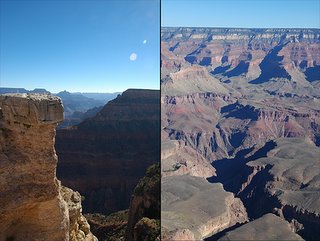
View from Mather Point
I went down the canyon, following the Bright Angel Trail to Plateau Point. On the upper part of the trail the cactus vegetation was rather sparse, but after having passed the Indian Gardens and entered the Blackbrush (Coleogyne ramosissima) dominated desertscrub on the Tonto Platform, the cacti became abundant.
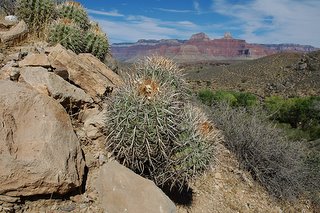
Echinocactus polycephalus overlooks the Tonto Platform
Especially Opuntias are massively present, almost covering the ground in some areas. I collected some Opuntia polyacantha var. hystricina seeds (thanks to the friendly people at the cacti_etc mailing list for helping me getting the name correct). The seed donor is depicted below.
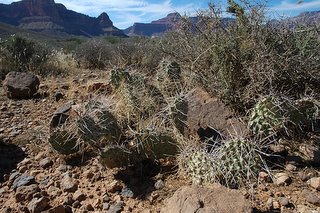
Opuntia polyacantha var. hystricina
I’m aware that it’s absolutely stupid to sow cactus seeds at this time of year (in the Northern Hemisphere, that is ;-), but I couldn’t resist the temptation of testing the viability of the seeds. Prior to sowing I soaked the seeds for 14 days and after an additional two weeks in the ground 50% of the seeds have now germinated. I expected the seedlings to be “leggy” but was a bit surprised to see what looks like a tricotyledon?
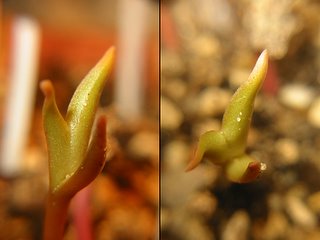
Tricotyledon Opuntia seedling
The Grand Canyon hike took place September 24, 2005. Additional photos can be found at Grand Canyon Cacti & Succulents.
All Time Most Popular Posts
-
Lophophora williamsii (peyote) populations have diminished in large areas of South Texas where peyoteros harvest the cactus for ceremonial ...
-
On various occasions I've been asked what growing media I'm using for my cactus plants. I don't have a set soil mix recipe as su...
-
Below is a list of retailers/nurseries selling cactus seed and plants. I've only listed vendors I've done business with. If you ar...
-
Most cacti are easily grown from seed - and with a little patience and care they can be grown into beautiful plants. Lophophora williamsi...
-
In last month’s post on the troubled Texan peyoteros I referred to Anderson’s article on the peyote situation in Texas. Given the importanc...
-
Yet another slightly off topic and probably not entirely politically correct post, but I couldn’t help noticing the similarity of my monstr...
-
Flowering stand of San Pedro cacti (Trichocereus pachanoi) To me the main draw of the San Pedro cactus ( Trichocereus pachanoi (syn. Ech...
-
In the June 2008 issue of the Cactus & Co magazine Jaroslav Šnicer, Jaroslav Bohata, and Vojtěch Myšák described a new Lophophora spec...
-
There seems to be an increased focus on the alarming Texas peyote situation. A couple of weeks ago the Houston Press published a mournful, i...
-
I spent two weeks working in Delhi, India during January. I had one weekend off and had planned to spend it in Delhi at my own leisure, but ...


















